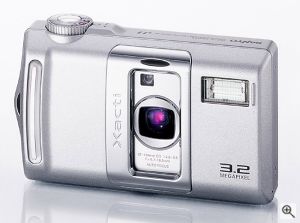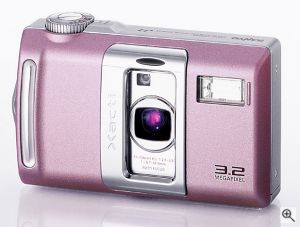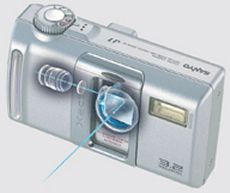The announcement has now happened, and the new Sanyo Xacti (pronounced Zack-Tee) DSC-J1 looks to be quite an interesting little camera. Available in two colors - silver or "misty pink", the 'J1 will cost ¥60,000 (US$496 / €462 / CDN$758 / £307 excluding exchange rate fluctuations, duties and taxes. The camera will reach the Japanese market in the middle of March 2003, with a monthly production of some 30,000 units.
Sanyo are claiming the DSC-J1, which follows in the footsteps of past Sanyo cameras with impressive video performance, will have "the industry's highest quality movie mode in a non-commercial digital camera", and be suitable for authoring DVD video. The video mode is unusual in using the higher-quality QuickTime PhotoJPEG compression format, instead of the lower-quality QuickTime MotionJPEG - and at up to 640 x 480 pixels, 30 frames per second ranks up there at the top of the current crop of consumer digital cameras in movie size. In 160 x 120 pixel mode at 15 frames per second, video length is up to a maximum of 100 minutes per clip on a 512MB SD card. Pixel doubling technology in the movie mode allows increased ISO sensitivity up to a rating of ISO 1600 maximum.
Sanyo becomes the second company to use a prism to fold the light path of the lens with the DSC-J1, following in the footsteps of Minolta's DiMAGE X and Xi cameras. The advantage of the technique is that the entire lens structure can be kept inside the camera - making the camera faster to start up, zoom operation quieter, keeping power consumption down, and protecting the lens structure from damage. There is a downside to the design though, in that the prisms look to degrade image quality slightly from what we've seen in testing. Still, Sanyo says the DSC-J1 will start up in 1.2 seconds, and has an impressively low shutter-lag of just 0.05 seconds from focus capture to the image being taken. Switching to playback mode takes 0.6 seconds, and the cycle time from shot to shot is 1.6 seconds.
Unfortunately, Sanyo remains one of the few companies clinging to that most dreaded of words, "interpolation". The company says that the interpolation technology in the DSC-J1 will allow A4 prints, but realistically interpolating images in-camera wastes valuable flash-card space for little (if any) gain over what could be achieved interpolating images on a personal computer. The maximum interpolated image size on the DSC-J1 is 2880 x 2160 pixels, but the real image size is 2048 x 1536 pixels.
The camera is apparently also designed to be friendly to beginners, featuring scene modes to help you get the shot you want, and two rather more unusual features. A 7-color "Rainbow Illumination" LED light blinks on the front of the camera, indicating when the camera is turned on, when a still image has been taken, when the self-timer is in use or when the camera mode is changed. Meanwhile, what we think is being described as a "friendly neighbor" feature warns you audibly when you are taking a movie in case you were intending to capture a still image, and also warns you if there is no flash-card in the camera.
Sanyo says another industry-record for the DSC-J1 (excluding commercial cameras and camcorders) is the high 60 frames per second refresh rate of the camera's LCD. The 'J1 also has a 5-point autofocus system, with focus points indicated on the LCD display. A 1090 mAh Lithium Ion rechargeable battery coupled with a new power management algorithm provides 1.7 times the battery life of Sanyo's own DSC-MZ3 digital camera, up to 110 minutes of continuous use with LCD. The use of magnesium alloys in the chassis increases rigidity 70% over the MZ3, with a total weight of 150 grams - or 185 grams with SD card and battery.
Other features include a 4x digital zoom function in record mode, up to 45x playback zoom in the interpolated [2880] image mode, the ability to crop images in-camera, a super-macro mode that focuses down to 2 centimeters, a wide focusing range from 20cm to infinity when not in macro mode, a "Best Shot Selection" function which captures four images and lets you choose the best, a five-shot automatic exposure bracketing function, a voice-memo mode (10-second clips per picture), a voice-recorder mode (up to 9 hours of audio), a PC camera mode to allow for tethered videoconferencing, a dual menu-system (hiding or displaying advanced setup options), Exif Print, PRINT Image Matching II and USB Direct-Print compliance, and a bundle including Ulead Photo Explorer 8.0 SE Basic for Windows.
Full specifications courtesy of Sanyo follow:
| Sanyo Xacti DSC-J1 |
 |
| Model | DSC-J1 |
| Effective Pixels | Approx. 3,200,000 pixels |
| Imaging Element | 1/2.7" primary color interlaced scanning CCD with 3,340,000 pixels (total) |
| Recording Medium | SD Memory card / MultiMediaCard |
| File Format | | Still Image: JPEG (DCF), DPOF, Exif Ver2.2 conforming | | Movie: QuickTime Movie (Photo-JPEG), Audio: WAVE (monaural) | |
| Image Size | Still Image:
[2880]: 2880x2160 pixels,
[2048]:2048x1536 pixel,
[1600]: 1600x1200 pixels,
[640]:640x480 pixel | | Burst Mode:
[2048]: 2048x1536 pixels,
[1600]:1600x1200 pixel,
[640]: 640x480 pixels | Movie:
[640]: 640x480 pixels,
[320]:320x240 pixel,
[160]: 160x120 pixels | |
| Lens | | f = 5.7 - 16.0mm (35mm equivalent: 37 - 104mm) | | 2.8x optical zoom lens with prism to fold light-path | | F2.8 (W) - F3.9 (T) Auto focus | |
| Focusing Distance | | Standard: 20cm (W) / 30cm (T) - Infinity | | Macro: 2cm (W) / 30cm (T) - 50cm | |
| Shutter Speed | | Still Image: 1/2 - 1/2000 second | | Still Image w/ Flash: 1/30 - 1/2000 second | | Bulb Mode: Up to 4 seconds | | Movie: 1/30 - 1/10000 second | |
| Digital Zoom | | Record: Up to 4x (except for [2880] pixel mode | | Playback: Up to 45x (in [2880] pixel mode | |
| Exposure Control | | Program AE | | Exposure compensation: ±1.8EV (0.3EV steps) | |
| Metering | Average / Center-Weighted / Spot |
| Sensitivity | | Still Image: Auto (approx. ISO 50 - 200), Manual (ISO 50 / 100 / 200 / 400) | | Movie: Auto (approx. ISO 200 - 800), Manual (ISO 200 / 400 / 800 / 1600) | |
| White Balance | | Auto: Full auto TTL | | Manual: 5 presets | |
| Flash | | Automatic / On / Off / Red-eye reduction | | (Slow sync possible in Night Scene mode) | |
| Sound | | Microphone: Built-in monaural | | Speaker: Built-in monaural | |
| LCD Display | 1.6" TFT LCD with approx. 80,000 pixels (100% coverage when AV cable is not connected only) |
| Viewfinder | Optical real-image zoom |
| Interface | | AV Out: (Video: Composite NTSC / Sound: Mono connector) | | USB 1.1 (proprietary connector) | |
| Power Supply | | Lithium Ion Battery (DB-L10, included) | | AC adapter (DSA-47, optional) | |
| Battery Life | LCD Off, Record: Approx. 1150 images / LCD On, Record: Approx. 350 images / Playback: Approx. 200 minutes |
| Size / Weight | | 98 (W) x 57 (H) x 31 (D) mm (excluding projections) | | Approx. 150g (body only), Approx. 185g (picture-ready) | |
| Included Accessories | 8MB SD Memory Card, proprietary AV cable, proprietary USB cable, Sanyo Software Pack 6.4 CD-ROM, Lithium Ion battery, charger and power cord, hand strap |
| More Photos |
 |
 |
| . |